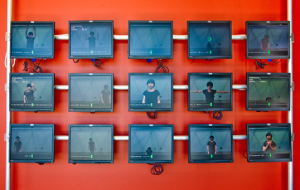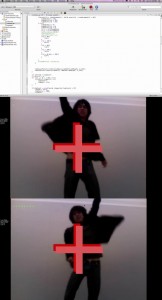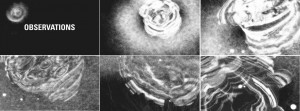Issue 28 11.20.13

Body and Imagination: The Work of Nik Hanselmann
by Dorothy Santos
“I am a big believer that work should perform and be as it is — that whatever phenomena you are trying to describe be embedded in the work itself. But I also think that the somewhat anachronistic attributes of past media have a significant weight on how work can be put into conversations today.
~ Nik Hanselmann, Artist
With the release of latest touch screen devices, consumers gather in droves as if making a sacred pilgrimage. Not only do these devotees want to be one of the privileged individuals to partake in the latest technology but these very devices are seen as a way to socially engage and entertain. The multi-layer instantaneous retinal stimulation of our youtube-flickr google-able culture make participation in society highly accessible. Everyone has the ability to create. This is where the artist creates distinctions and much needed discourse. Video art, specifically, has taken on countless iterations of the relationship between filmmaker and viewer. In recent years, new media artists have used technologies that require the viewer to become a part of the production of the art but what happens when the artist intervenes by taking away the right of interaction and interconnectivity away from the participant and relegates them viewer?
The creative use of (programming) language to design and, in some cases, fabricate a specific reality or experience is when the medium becomes the subject. Similar to the abstract expressionists, some new media artists finds ways to repurpose the tools and techniques in an unorthodox fashion. The alternative method of producing film footage featuring organic forms may not be a foreign idea but programming language as the basis for creating a new format for video art is suggestive of how new media artists push the boundaries regarding the definition of the art object. Nik Hanselmann’s works utilize the body in different ways and piques the imagination as a point of departure for inquiry into the separation between artist, artwork, and observer in his works, bodyfuck and Observations.
In bodyfuck, Hanselmann created a unique programming language involving use of the body as a means of production. In this scenario, the artist becomes the spectacle. The piece entails a short video of the artist jumping and moving side to side within the frame of the screen. Grandiose gestures and exaggerated movements result in a specific character or symbol revealed to the viewer. As the artist moves, another character flashes on the screen. The cause and effect experience is not too dissimilar to a keystroke on a keyboard. Yet, Hanselmann’s breathy smile results in script that produces a short greeting – Hi. It is the entire body that produces the programming language, the symbols, and the text. In speaking with the artist, he states,
“…bodyfuck was comic “virtuosity” or bodily absurdity – something which ended up being a lot more physically punishing than I imagined before I set out to do the project. I think this is really important – and it’s not something that I would wish upon the audience. On a pragmatic level, it wouldn’t really work to have a bunch of non-programmer gallery-goers to be suddenly faced with the challenge or programming.”
~ Nik Hanselmann
It is the body, in the end, that exerts (maybe even suffers) itself to some degree, which harks back to the days of experimental video art where the artist performed for the viewer. Yet, bodyfuck serves as a metaphor for the actual artistic process. Complexity within a process somehow seems to constantly produce something simplistic that may seem absurd to the viewer but it is the complex set of ideas that lay the foundation for innovation. The serendipitous discoveries lay dormant and only in the artist’s domain. They are revelatory and representative of the way watch and perceive the existence of the art object. Fictitious forms and organisms in Hanselmann’s piece, Observations, serve as another example of innovative tools used to construct a work that reveals something separate and outside of ourselves through abstraction.
“For Observations, the decision for non-interaction is to tinge the whole thing with hegemonic mystery. I’m fascinated by the idea of being an agent in science – most of us have little-to-no first-hand experience with most of the concepts that we take for granted. I think the video/screen in this context works like it did on the moon landing or the drop of an atomic bomb. The whole experience is so abstract but told with such authority. That is not to say of course that I think about the fictional phenomena I created on the same level of profundity – I’m merely calling back to this idea that the screen can be a frightening disconnect. In an age of interactivity, I think this gap is widened even further, as most of us can’t wait to get our greasy paws on something to pan, zoom, and eventually hit the home button to go tweet about it”.
~ Nik Hanselmann
Hanselmann’s works open up the discussion and examination of new media arts multi-faceted and rapidly evolving nature. Definition eludes new media (even though it’s been around for close to 40 years) in large part due to its resistance to fit snuggly into the canon of art history. It remains a nebulous topic primarily due to its ever rapidly evolving virtual landscape, meaning, and structure. The term new media alone connotes something discovered and cutting edge but what happens when there is constant flux and change in that very thing we are looking to define and provide taxonomy for. It becomes a task and a challenge for the artists to examine ways in which the tools can be used differently and perhaps in conjunction with one another to create abstraction from what is seemingly finite and concrete.


